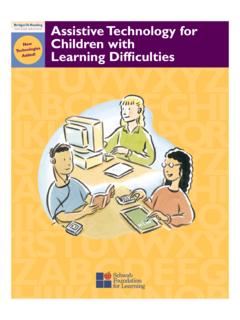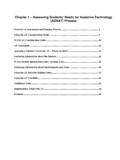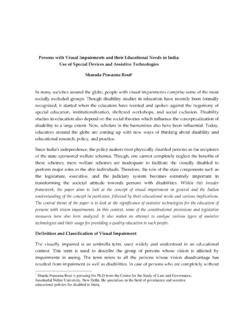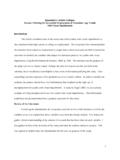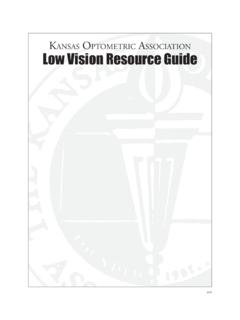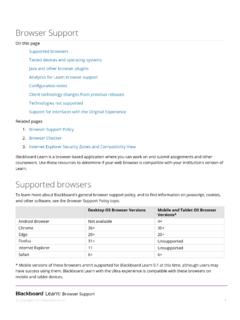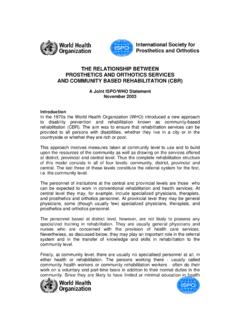Transcription of Individuals with Disabilities Education Improvement …
1 81 technology INTEGraTIONC opyright 2007 by the technology and Media Division (TaM) of the Council for Exceptional Mittler, Post Campus, Long Island UniversityOn December 2, 2004, President George W. Bush signed into law 108-446, the Individuals with Disability Education Improvement Act (IDEA 2004). The law took effect on July 1, 2005. The Final Rules and Regulations that expanded upon and/or explained various parts of IDEA 2004 were pub-lished on August 14, 2006. They took effect on October 13, 2006. The process leading up to the publication of the Final Rules and Regulations was a lengthy one. Initially, the U. S. Department of Education (DOE) asked professionals in the field to submit questions or concerns about IDEA 2004 that they wanted the rules to address. Several months after receiving those con-cerns, DOE officials published the Proposed Rules and Regulations, along with a lengthy document that explained their thinking behind them.
2 As required by law, interested parties had 75 days to submit comments in writing or at a series of DOE-scheduled meetings held in various locations across the country. The DOE received approximately 5,500 comments. As required by law, each comment must be addressed as part of the Final Regulations. To this end, in August 2006, the DOE issued another very lengthy document that accompa-nied the Final Rules and is a brief summary of how IDEA 2004 addresses assistive technology for students with Disabilities . assistive technology and IDEA: RegulationsIDEa was reauthorized in 2004. Here is a brief summary of how IDEa 2004 addresses assistive technology for students with with Disabilities Education Improvement Act of 2004 From: Mittler, J. (2007). assistive technology and IDEA. In C. Warger (Ed.), technology integration: Providing access to the curriculum for students with Disabilities . Arlington, VA: technology and Media Division (TAM).
3 82 technology INTEGraTIONC opyright 2007 by the technology and Media Division (TaM) of the Council for Exceptional 2004 and assistive technology A Summary of ChangesIDEA 2004 was not intended to overhaul its pre-decessor, IDEA 1997, but rather address some issues that had arisen during the intervening few years. Thus, aside from some noteworthy changes in the Individualized Education Program (IEP) procedures, due process, discipline, and a few other areas, it only minimally modified the exist-ing references to assistive technology . Yet, even modest changes may prove significant. The requirement that every child must be con-sidered for assistive technology remains intact. The regulations state: assistive technology .(a) Each public agency must ensure that assistive technology devices or assistive technology services, or both, as those terms are defined in and , respectively, are made available to a child with a disability if required as a part of the child s (1) Special Education under ;(2) Related services under ; or(3) Supplementary aids and services under and (a)(2)(ii).
4 (b) On a case-by-case basis, the use of school-purchased assistive technology de-vices in a child s home or in other settings is required if the child s IEP Team deter-mines that the child needs access to those devices in order to receive Development, review, and revi-sion of IEP.(a) Development of IEP (1) General. In developing each child s IEP, the IEP Team must consider (i) The strengths of the child;(ii) The concerns of the parents for en-hancing the Education of their child;(iii) The results of the initial or most re-cent evaluation of the child; and(iv) The academic, developmental, and functional needs of the child.(2) Consideration of special IEP Team must (i) In the case of a child whose behavior impedes the child s learning or that of oth-ers, consider the use of positive behavioral interventions and supports, and other strategies, to address that behavior;(ii) In the case of a child with limited English proficiency, consider the language needs of the child as those needs relate to the child s IEP;(iii) In the case of a child who is blind or visually impaired, provide for instruction in Braille and the use of Braille unless the IEP Team determines, after an evaluation of the child s reading and writing skills, needs, and appropriate reading and writ-ing media (including an evaluation of the child s future needs for instruction in Braille or the use of Braille), that instruc-tion in Braille or the use of Braille is not appropriate for the child.
5 (iv) Consider the communication needs of the child, and in the case of a child who is deaf or hard of hearing, consider the child s language and communication needs, opportunities for direct com-munications with peers and professional personnel in the child s language and com-munication mode, academic level, and full range of needs, including opportunities for 83 technology INTEGraTIONC opyright 2007 by the technology and Media Division (TaM) of the Council for Exceptional instruction in the child s language and communication mode; and (v) Consider whether the child needs assistive technology devices and services (emphasis mine).One small, but potentially important change in IDEA 2004 was the replacement of the word requires as in Consider whether the child requires (emphasis added) assistive technology devices and services that appeared in IDEA 1997 with the word needs. IDEA 2004 in-cludes the directive that every IEP should Con-sider whether the child needs (emphasis added) assistive technology devices and services.
6 While it is hard to know if this change will have any impact on IEP teams, it might prove a bit confusing as teams try to decipher the reason for the change. One promising possibility is that the word needs will result in a more liberal inter-pretation of assistive technology than the word requires. This could ultimately result in more children being able to access available devices and services. Perhaps the most noticeable change in IDEA 2004 is the definition of an assistive technology device. The regulations state: assistive technology technology device means any item, piece of equipment, or product sys-tem, whether acquired commercially off the shelf, modified, or customized, that is used to increase, maintain, or improve the functional capabilities of a child with a disability. The term does not include a medical device that is surgically implanted, or the replacement of such 2004 continues to define an assistive technology device as any item, piece of equip-ment, or product system that is used to increase, maintain, or improve the functional capabilities of the child.
7 However, it specifically excludes a medical device that is surgically implanted or the replacement of such a device. This change is usu-ally thought to apply to cochlear implants, but it might also refer to any device that is surgically implanted to assist in a bodily function such as breathing, eating, etc. Most comments concerning assistive technology related to this change. They included comments directly opposing it. With the specific wording in the law, however, there is little that can be done to change it s meaning or to explain ambiguities. Thus, there were no changes in this section of the regulations. A similar exclusion for surgically implanted de-vices exists in the definition of related services. However, this same regulation on related services permits the checking of hearing aids and the ex-ternal components of surgically implanted devic-es to see if they are turned on and change in the regulations that may prove to be significant concerns the review and revision of IEPs.
8 The IDEA 1997 regulations specifically state that when reviewing or revising an IEP, the special factors, including the consideration of assistive technology , must be included. The pro-posed IDEA 2004 regulations eliminated that requirement, creating a situation whereby assis-tive technology cannot be added (or modified) in any IEPs beyond the original one. Several comments (including those of this au-thor) pointed out that such a restriction would limit the ability of a child to receive an appropri-84 technology INTEGraTIONC opyright 2007 by the technology and Media Division (TaM) of the Council for Exceptional Education . Fortunately the regulators agreed and a new paragraph was added permitting the consideration of assistive technology (and the other special factors) during a review or revision of the IEP. The regulations state: Development, review, and revi-sion of IEP.(b) Review and revision of IEPs (1) General.
9 Each public agency must en-sure that, subject to paragraphs (b)(2) and (b)(3) of this section, the IEP Team (i) Reviews the child s IEP periodically, but not less than annually, to determine whether the annual goals for the child are being achieved; and (ii) Revises the IEP, as appropriate, to ad-dress (A) Any lack of expected progress to-ward the annual goals described in (a)(2), and in the general educa-tion curriculum, if appropriate; (B) The results of any reevaluation con-ducted under ;(C) Information about the child provided to, or by, the parents, asdescribed under (a)(2);(D) The child s anticipated needs; or (E) Other matters.(2) Consideration of special factors. In conducting a review of the child s IEP, the IEP Team must consider the special fac-tors described in paragraph (a)(2) of this only did the regulation maintain that criti-cally important practice in the IEP process, but it also demonstrated the validity of the commenting process in the development of the Design and IDEA 2004 IDEA 2004 also references universal design in the law and the regulations.
10 While several com-menter s referred to the definition of universal design and asked for modifications, the regula-tors responded that IDEA 2004 refers to the def-inition in the assistive technology Act of 1998 and cannot be modified. That definition states:(17) UNIVERSAL DESIGN. The term univer-sal design means a concept or philosophy for designing and delivering products and services that are usable by people with the widest possible range of functional capabilities, which include products and services that are directly accessible (with-out requiring assistive technologies) and products and services that are made usable with assistive technologies. (Section 3 of the assistive technology Act of 1998, as amended, 29 3002.)Accessibility and IDEA 2004 Perhaps the most significant assistive technology -related addition in IDEA 2004, which is includ-ed in the published regulations, is the provision that all students who are blind and individu-als with print Disabilities in elementary schools and secondary schools have access to print in-structional materials including textbooks in accessible format, free of charge.

